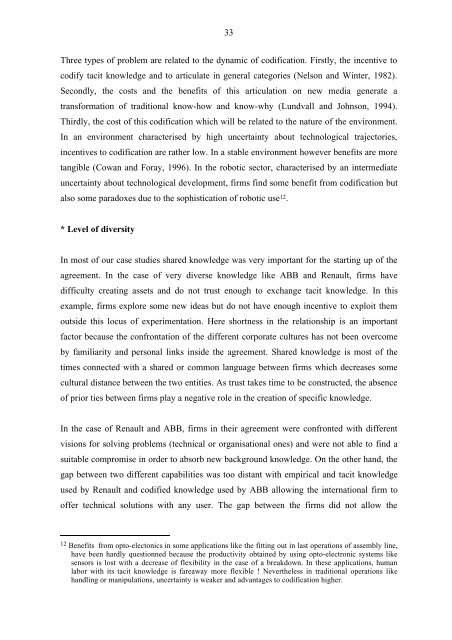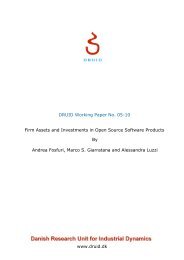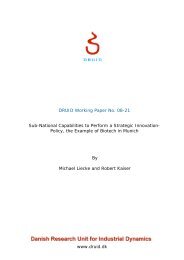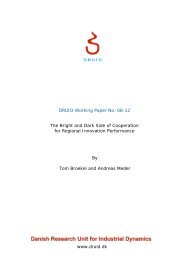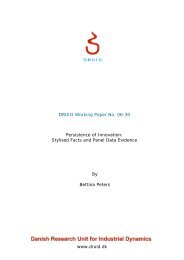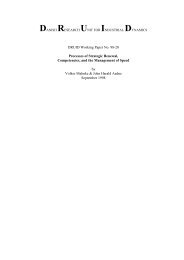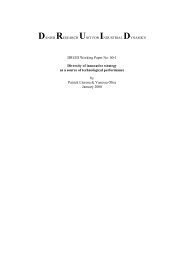danish research unit for industrial dynamics druid working paper no ...
danish research unit for industrial dynamics druid working paper no ...
danish research unit for industrial dynamics druid working paper no ...
Create successful ePaper yourself
Turn your PDF publications into a flip-book with our unique Google optimized e-Paper software.
33Three types of problem are related to the dynamic of codification. Firstly, the incentive tocodify tacit k<strong>no</strong>wledge and to articulate in general categories (Nelson and Winter, 1982).Secondly, the costs and the benefits of this articulation on new media generate atrans<strong>for</strong>mation of traditional k<strong>no</strong>w-how and k<strong>no</strong>w-why (Lundvall and Johnson, 1994).Thirdly, the cost of this codification which will be related to the nature of the environment.In an environment characterised by high uncertainty about tech<strong>no</strong>logical trajectories,incentives to codification are rather low. In a stable environment however benefits are moretangible (Cowan and Foray, 1996). In the robotic sector, characterised by an intermediateuncertainty about tech<strong>no</strong>logical development, firms find some benefit from codification butalso some paradoxes due to the sophistication of robotic use 12 .* Level of diversityIn most of our case studies shared k<strong>no</strong>wledge was very important <strong>for</strong> the starting up of theagreement. In the case of very diverse k<strong>no</strong>wledge like ABB and Renault, firms havedifficulty creating assets and do <strong>no</strong>t trust e<strong>no</strong>ugh to exchange tacit k<strong>no</strong>wledge. In thisexample, firms explore some new ideas but do <strong>no</strong>t have e<strong>no</strong>ugh incentive to exploit themoutside this locus of experimentation. Here shortness in the relationship is an importantfactor because the confrontation of the different corporate cultures has <strong>no</strong>t been overcomeby familiarity and personal links inside the agreement. Shared k<strong>no</strong>wledge is most of thetimes connected with a shared or common language between firms which decreases somecultural distance between the two entities. As trust takes time to be constructed, the absenceof prior ties between firms play a negative role in the creation of specific k<strong>no</strong>wledge.In the case of Renault and ABB, firms in their agreement were confronted with differentvisions <strong>for</strong> solving problems (technical or organisational ones) and were <strong>no</strong>t able to find asuitable compromise in order to absorb new background k<strong>no</strong>wledge. On the other hand, thegap between two different capabilities was too distant with empirical and tacit k<strong>no</strong>wledgeused by Renault and codified k<strong>no</strong>wledge used by ABB allowing the international firm tooffer technical solutions with any user. The gap between the firms did <strong>no</strong>t allow the12 Benefits from opto-electonics in some applications like the fitting out in last operations of assembly line,have been hardly questionned because the productivity obtained by using opto-electronic systems likesensors is lost with a decrease of flexibility in the case of a breakdown. In these applications, humanlabor with its tacit k<strong>no</strong>wledge is fareaway more flexible ! Nevertheless in traditional operations likehandling or manipulations, uncertainty is weaker and advantages to codification higher.


